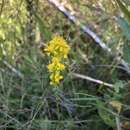Comments
provided by eFloras
Solidago pulchra is a distinct species, not easily confused once seen in the field. It is known only from Brunswick, Pender, and Onslow counties, where it occurs in scattered populations of few to numerous individuals. The basally fused and flattened pappus bristles are very unusual in the genus. Occurrence of the species in South Carolina is unconfirmed.
- license
- cc-by-nc-sa-3.0
- copyright
- Missouri Botanical Garden, 4344 Shaw Boulevard, St. Louis, MO, 63110 USA
Description
provided by eFloras
Plants 20–60(–80) cm, glabrous; caudices short or crowns. Stems 1, erect, slender. Leaves: basal tufted, tapering, petiolate, petioles 20–100 mm, blades oblanceolate or elliptic, 30–120 (including petiole) × 5–15 mm, obtuse to rounded; cauline sessile, blades oblanceolate to linear-lanceolate, 5–80 × 4–1.3 mm, abruptly reduced proximally, becoming bractlike proximal to arrays. Heads 5–20(–50), in slender racemiform or paniculiform arrays, sometimes secund and apically recurved, more often erect and not secund, sometimes compact and somewhat rounded to only slightly elongate. Peduncles 2–25 mm; bracteoles crowded, linear, 1–2 mm, grading into phyllaries. Involucres broadly campanulate, 3.5–5 mm. Phyllaries in 3–4 series, linear-lanceolate, strongly unequal, acute to slightly acuminate or cuspidate, glabrous. Ray florets 6–14; laminae 2–3 × 1–2 mm. Disc florets mostly 12–30; corollas 3.5–4 mm, lobes 0.5–0.75 mm. Cypselae 1.5–2 mm, sparsely finely strigose; pappi (basally broader and flattened, fused to varying lengths) 3–4 mm (somewhat clavate). 2n = 36.
- license
- cc-by-nc-sa-3.0
- copyright
- Missouri Botanical Garden, 4344 Shaw Boulevard, St. Louis, MO, 63110 USA
Solidago pulchra: Brief Summary
provided by wikipedia EN
Solidago pulchra, the Carolina goldenrod, is a rare North American plant species in the family Asteraceae. It has been found only in the states of North Carolina and South Carolina in the southeastern United States.
Solidago pulchra is a hairless perennial herb up to 80 cm (32 inches) tall, with a branched woody rootstock. One plant can produce as many as 50 flower in an elongated array. Ray flowers are yellow, 6-14 per head. Disc flowers number 12-30 per head. The species grows in moist, sandy depressions in pine woodlands.
- license
- cc-by-sa-3.0
- copyright
- Wikipedia authors and editors

